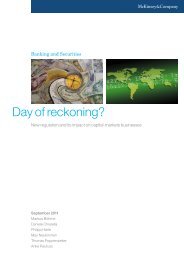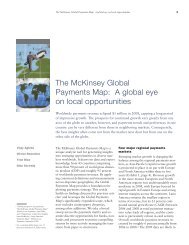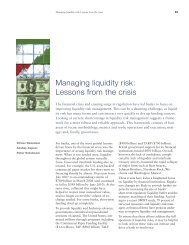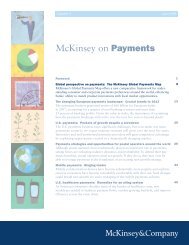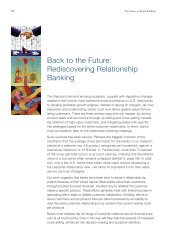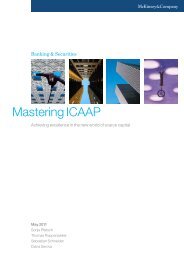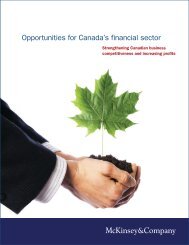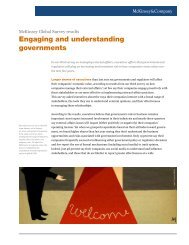Create successful ePaper yourself
Turn your PDF publications into a flip-book with our unique Google optimized e-Paper software.
18 The Future of Retail Bankingsaving more. The average consumer saved 1.8 percent of discretionaryspending in 2008, triple the 0.6 percent in 2007. We expect that number tonearly triple again in 2010 and to remain high for the foreseeable future.Cardholders are also voluntarily paying off balances and closing accounts:voluntary attrition in December 2009 was 9.3 percent, an increase of 30 percentover the average for 2008. Finally, the use of revolving debt was downby 13.3 percent in September 2009, the largest drop since December 1976.Furthermore, consumers are leaving their credit cards at home in favor oftheir debit cards. Visa and MasterCard’s second quarter 2010 credit chargevolumes were down 4 and 15 percent, respectively, compared to the secondquarter of 2008, while debit volumes rose 26 and 4 percent, respectively.Visa reported that total dollar volumes of purchases made with its brandeddebit cards exceeded credit card purchases for the first time ever in thefourth quarter of 2008.We expect this reduction in consumer debt and shift in spending behavior tolast, with enormous consequences for the card industry. Issuers are going tobe forced to think beyond their traditional notion of growth in outstandingbalances if they are to attract this new breed of debt-averse consumer.Exhibit 2Direct mail credit card solicitations fell 67% in 2009Mail solicitationsU.S.$ billions8.38.37.45.4-67%1.820052006200720082009Source: Mintel Comperemedia
20 The Future of Retail BankingOn average, U.S. banks have sold credit cards to 20 to 22 percent of theirretail banking customers, with leading institutions reaching penetrationrates of 35 to 40 percent. These numbers leave a great deal of room forgrowth: outside the U.S., some banks have achieved penetration rates ofmore than 50 percent despite operating in lessdeveloped credit card markets.To improve cross-selling ratesin the new environment, bankissuers need to understand whichchannels to emphasize, improvethe marketing infrastructure,and ensure the products aresuitably integrated.To improve cross-selling rates in the new environment,bank issuers need to understand whichchannels to emphasize, improve the marketinginfrastructure, and ensure the products are suitablyintegrated.Multichannel: Although some institutions todaygenerate nearly 30 new accounts per brancheach month, the branch alone will not beenough. Issuers will also need to use their online, call center and even ATMchannels to push acquisition rates higher.Marketing infrastructure: Issuers must do a better job of using the relationshipdata and information they have on customers to tailor and target productsand offers and evaluate credit. For example, bank issuers couldpre-qualify their entire retail customer base for credit cards so sales staffcan offer customers the product knowing they will be accepted. These decisionswill then need to be pushed out to frontline branch, call-center andonline channels.Product: The card offering could be integrated more tightly with retail bankofferings – e.g., with overdraft credit lines, integrating transaction data withdebit and bill pay for spending analysis, direct debit of payments, integratedstatements, etc. This would enhance cross-sell appeal, but new capabilitieswould need to be developed.Partnering for mutual benefitIssuers do not have to be a bank with an extensive branch network toplay the relationship game. They can also partner in developing distinctivevalue propositions and use partners’ low-cost acquisition channels. Theold co-brand partnership model should be a thing of the past. The newparadigm is about meeting a partner’s core business needs and buildingreal customer loyalty, rather than focusing on points and “10 percent offfirst purchase” deals.
U.S. <strong>Credit</strong> <strong>Cards</strong>: Looking at the Business Through a Long-Term Lens21When designing partnerships, issuers need to consider both the needs oftheir partners and the needs of their partners’ customers.Issuers should consider how digitaltechnologies can enhance thecustomer experience whilestripping out costs. Moving todigital marketing alone couldreduce the overall cost structure by30 to 40 percent.Deal structure with partners: Issuers will have to become more attunedto the core business needs of their partners. For example, the partnermay be trying to enter new markets, drive trip frequency, or get customersto buy new categories or try new channels. Meeting a partner’sneeds will likely lead to more partner engagement and better card economics.Another solution could be to strike profit-sharing deals thatallow partners to benefit from the true upside rather than the traditional“bounty” payment for new accounts and purchasing points.Value proposition for end customers: Customers want a positive experiencefrom the partner, and partners want to improve customerloyalty. The two should not be hard to matchup, assuming the card issuer understands theunderlying motivations. For instance, tieredpoints-based airline programs could be revampedto support an airline’s goal of raisingrevenue through baggage fees and on-boardfood sales, while delivering meaningful experientialrewards to customers, such as frequentflyer status, upgrades, or priority boardingrather than points. Some partnerships have alreadyexperimented with this:Continental/Chase gives cardholders their first checked bag free,while Delta/American Express awards elite qualifying miles that counttoward higher status. These are still only targeted efforts and fallshort of being fundamental changes in the core value proposition toharness the power of experiential rewards, but they are a step in theright direction.Reinvention in the digital ageIssuers should consider how digital technologies can enhance the customerexperience while stripping out costs. Moving to digital marketingalone could reduce the overall cost structure by 30 to 40 percent. This isstill a business that relies too heavily on paper: direct mail, statements,check remittances, etc. Issuers should embrace the full capabilities of theWeb and other digital technologies. Imagine what the user interface wouldlook like if Apple issued an “iCard.”
22 The Future of Retail BankingTo date, most issuers have only recreated their paper statements online,making no attempts to use the full capabilities of the Web. But taking paperout of the system means more than just having a PDF version of a statementfor download.There are also clear business benefits beyond cost-cutting. Steering customerstowards direct debit to pay card bills actually improves the risk profileof the customer and takes the check remittance out of the system.* * *The credit card industry has been incredibly resilient and innovative overmany decades. It developed rewards and affinity value propositions, perfecteddirect mail in financial services and took analytics-based marketingand pricing to a new level. The challenges facing the industry today aredaunting and have brought it to another crossroads. It is time for the industryto find innovative ways to serve consumers and to reinvent the business forcontinued growth and profitability.Note: This article is an updated version of an article of the same title that appeared in <strong>McKinsey</strong> on Payments, June 2009.
About <strong>McKinsey</strong> & <strong>Company</strong><strong>McKinsey</strong> & <strong>Company</strong> is a management consulting firm that helps many of theworld’s leading corporations and organizations address their strategic challenges,from reorganizing for long-term growth to improving business performanceand maximizing profitability. For more than 80 years, the firm’s primaryobjective has been to serve as an organization’s most trusted external advisoron critical issues facing senior management. With consultants in more than 40countries around the globe, <strong>McKinsey</strong> advises clients on strategic, operational,organizational and technological issues.<strong>McKinsey</strong>’s Consumer & Small Business Banking Practice serves leadingNorth American banks on issues of strategy and growth, operations and technology,marketing and sales, organizational effectiveness, risk managementand corporate finance. Our partners and consultants provide expert perspectiveson a range of topics including corporate strategy, business model redesign,product and market strategy, distribution and channel management,the impact of financial services regulation and performance improvement.The following <strong>McKinsey</strong> consultants and experts contributed tothis compendium:Whit AlexanderDaina GrayboschJames McKayGreg PhalinPhilip BrunoTommy JacobsHoward MosesonLeonardo RinaldiRobert ByrnePiotr KaminskiSudip MukherjeePablo SimoneLiam CaffreyRami KarjianFritz NauckVik SohoniPrasenjitChakravartiDavid ChubakMarco De FreitasBenjamin EllisAkshay KapoorCatharine KellyNick MalikRobert MauSandra NudelmanMarukel NunezPradip PatiathJohn PatienceDorian StoneSarah StraussAmeesh VakhariaTim WelshContactFor more information, contact:Nick MalikDirector(212) 446-8530nick malik@mckinsey.comChristopher LeechDirector(412) 804-2718chris leech@mckinsey.comMarukel NunezPrincipal(212) 446-7632marukel nunez@mckinsey.com
Financial Services PracticeNovember 2010Designed by Hudspith DesignCopyright © <strong>McKinsey</strong> & <strong>Company</strong>www.mckinsey.com/clientservice/financial_services



